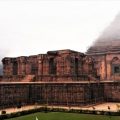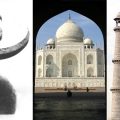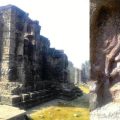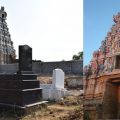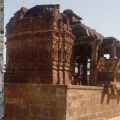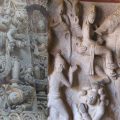The Balochistan Sphinx Temple Complex: Is It a Man-made Architectural Wonder?
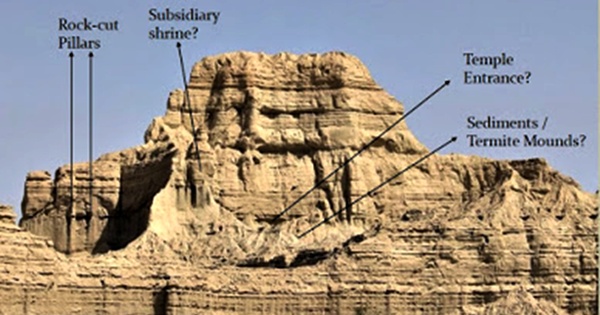
Concealed within the desolate, rocky, landscape of the Makran coastline of Southern Balochistan, Pakistan, is an architectural gem that has gone unnoticed and unexplored for centuries. The Balochistan Sphinx, as it is popularly called, came into the public eye only after the Makran Coastal Highway opened in 2004, linking Karachi with the port town of Gwadar on the Makran coast.
A four-hour long drive (240 kms) from Karachi, through meandering mountain passes and arid valleys, brings one to the Hingol National Park where the sphinx is located.
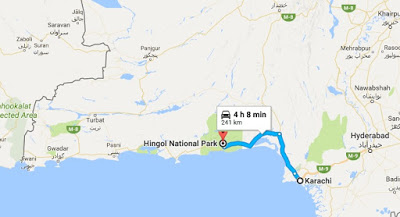
Fig 1: It is a four-hour drive from Karachi to the Hingol National Park along the Makran Coastal Highway. The Balochistan Sphinx is located inside the Hingol National Park. Source: Google Maps
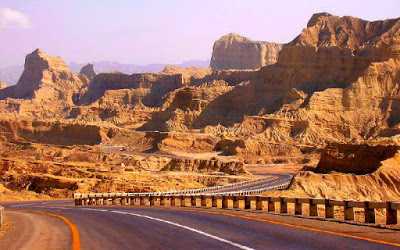
Fig 2: The Makran Coastal Highway. Source: www.tresbohemes.com

Fig 3: The Balochistan Sphinx inside the Hingol National Park. Credit: Wikimedia Commons / Bilal Mirza CC BY 2.0
A cursory glance at the impressive sculpture shows that the sphinx has a well-defined jawline, and clearly discernible facial features such as the eyes, nose, and the mouth, which are placed in perfect proportion to each other.
The sphinx appears to be decked up in a head-dress that closely resembles the Nemes head-dress of the Egyptian pharaoh. The Nemes head-dress is a striped headcloth that covers the crown and back of the head. It has two large, conspicuous, flaps which hangs down behind the ears and in front of both shoulders. The ear-flaps can be clearly seen on the Balochistan sphinx (including some stripe marks on it as well). The sphinx has a horizontal groove across the forehead which corresponds to the pharaonic head-band that holds the Nemes head-dress in place.
One can easily make out the contours of the reclining forelegs of the sphinx, which terminate in very well-defined paws. It is difficult to see how nature could have carved out a statue which resembles a well-known mythical animal to such an extraordinarily high degree.
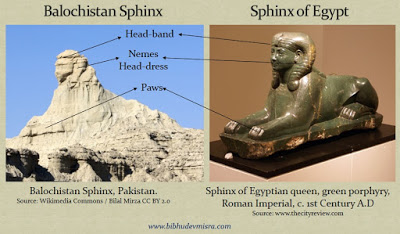
Fig 4: The Balochistan Sphinx resembles the Egyptian sphinxes in many respects.
The Sphinx Temple
In close proximity to the Balochistan Sphinx is another important structure. From a distance, it looks like a Hindu Temple (like those of South India), with the Mandapa (entrance hall) and the Vimana (temple spire). The top part of the Vimana appears to be missing. The sphinx is reclining in front of the temple, appearing to act as a protector of the sacred site.

Fig 5: The Balochistan Sphinx reclines in front of a temple-like structure. Source: www.pakistanpaedia.com
In sacred architecture, the sphinx always performed a protective function, and was generally placed in pairs on either side of the entrance to temples, tombs, and sacred monuments. In ancient Egypt, the Sphinx had the body of a lion, but its head could be that of a man (Androsphinx), a ram (Criosphinx) or a falcon (Hierocosphinx).[2] It was always regarded as a protector of temples or sacred places. The Great Sphinx of Giza, for instance, acts as a guardian of the Pyramid complex.
In Greece, the sphinx had the head of a woman, the wings of an eagle, the body of a lioness, and according to some, the tail of a serpent.[3] The colossal statue of the Sphinx of Naxos stood on a towering ionic column, at the sacred Oracle of Delphi, acting as a protector of the site.
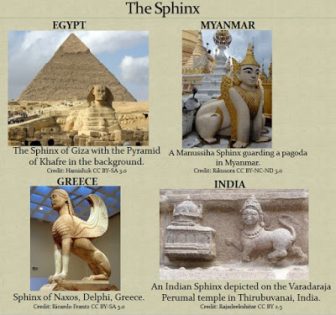
Fig 6: The Balochistan Sphinx Temple shows clear signs of being a man-made, rock-cut temple.
In Indian art and sculpture, the sphinx is known as purusha-mriga (meaning ‘man-beast’ in Sanskrit), and its primary position was near the temple gateway, acting as a guardian of the sanctuary.[4] However, sphinxes were sculpted all over the temple premises including the entrance gates (gopuram), halls (mandapa), near the central shrine (garba-griha) etc.
Raja Deekshithar had identified 3 basic forms of the Indian sphinx: a) A crouching sphinx with a human face, but with certain lion characteristics like mane and elongated ears; b) A striding or jumping sphinx with a fully human face; c) A half-upright or fully-upright sphinx, sometimes with moustaches and long beards, often in an act of worshipping a Shiva-linga.[5]
Sphinxes also feature in the Buddhist architecture of South-east Asia. In Myanmar, they are called Manusiha (from the Sanskrit manu-simha, meaning man-lion). They are depicted in a cat-like crouching posture at the corners of Buddhist stupas. They wear a tapering crown and ornamental ear-flaps, and have feathered wings attached to their front limbs.[6]
So, all across the ancient world, the sphinx acted as a protector of sacred places. The Sphinx of Balochistan also appears to be guarding the temple-like structure near it. This suggests that the site was laid out in accordance with the principles of sacred architecture.
A closer look at the Sphinx Temple shows clear evidence of pillars carved on the boundary wall. The temple entrance is visible behind a large pile-up of sediments or termite mounds. An elevated, sculpted, structure to the left of the entrance could be a subsidiary shrine. Overall, there can be little doubt that this a massive, man-made, rock-cut, monument of immense age.
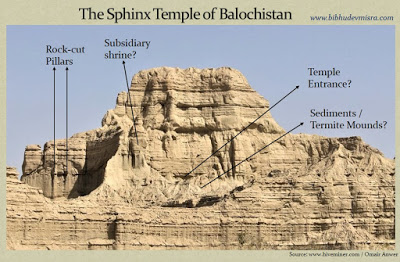
Fig 7: The Balochistan Sphinx Temple shows clear signs of being a man-made, rock-cut, temple
Interestingly, there seem to be two massive sculptures carved on the façade of the Sphinx Temple, right above the entrance, on either side.
The carvings are heavily eroded, making their identification difficult, but it looks as if the figure on the left could be Kartikeya (Skanda / Murugan) holding his spear (vel), while the figure on the right could be a striding Ganesha. Incidentally, both Kartikeya and Ganesha are sons of Shiva, which means that the temple complex could have been dedicated to Shiva.
While any identification at this stage is speculative, nevertheless, the presence of sculpted figures on the façade lends greater weight to this being a man-made structure.
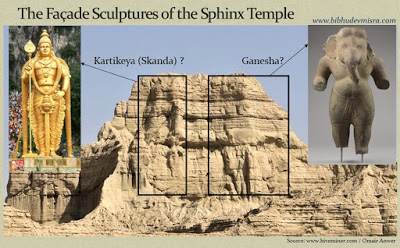
Fig 8: The facade carvings on the Balochistan Sphinx-Templecould be that of Kartikeya and Ganesha
The structure of the Sphinx Temple suggests that it may actually be a Gopuram i.e. the entrance tower of a temple. Like the Sphinx Temple, gopurams are generally flat-topped. Gopurams have a row of ornamental kalasams (stone or metal pots) arranged on top. If we look carefully at the flat-topped Sphinx Temple we can see a number of “spikes” on top, which could be a row of kalasams, covered with sediments or termite mounds.
Gopurams are attached to the boundary wall of a temple, and the Sphinx Temple appears to be contiguous with the outer boundary. Gopurams also have giant figures of dvarapalas i.e. door guardians sculpted on them, and, as we have noted, the Sphinx Temple has two massive figures carved on the façade, just above the entrance, which may be serving as the dvarapalas.
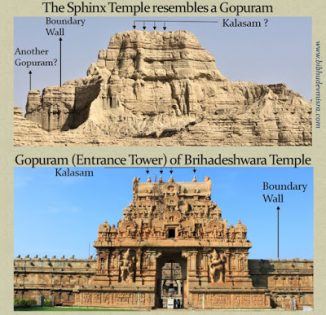
Fig 9: The Balochistan Sphinx-Temple could be a gopuram i.e. the entrance tower of a temple
An elevated structure to the left of the Sphinx Temple could be another gopuram. This implies that there could be four gopurams in the cardinal directions leading to a central courtyard, where the main shrine of the temple complex was built (which cannot be seen in the photograph). This kind of temple architecture is quite common in South Indian Temples.

Fig 10: The Arunachaleshwar Temple in Tamil Nadu, India, has four gopurams i.e. entrance towers in the cardinal directions. The temple complex houses numerous shrines. Source: Wikimedia Commons / Adam Jones CC BY-SA 3.0 adamjones.freeservers.com
The Sphinx Temple Platform
The elevated platform on which the Sphinx and the Temple are situated, appears to have been elaborately carved with pillars, niches, and a symmetric pattern that extends across the entire upper part of the platform. Some of the niches may well be doors which lead to chambers and halls under the Sphinx-Temple complex. It is believed by many that there could be chambers and passages under the Sphinx on the Giza plateau as well. It is also interesting to note that the Balochistan Sphinx and the Temple are situated on an elevated platform, just as the Sphinx and the Pyramids of Egypt were built on the Giza plateau overlooking the city of Cairo.
Another conspicuous feature of this site is a series of steps leading to the elevated platform. The steps appear to be evenly spaced, and of uniform height. The entire site gives the impression of a grand, rock-cut, architectural complex, which has been eroded by the elements, and covered by layers of sediment, masking the more intricate details of the sculptures.
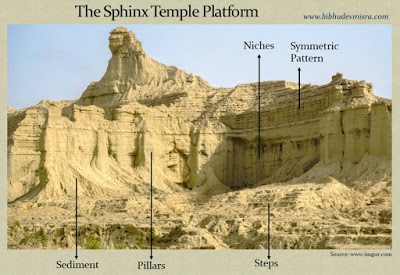
Fig 11: The Balochistan Sphinx-Temple platform with steps, pillars, niches and a symmetric pattern.
The term “Makran” is sometimes taken to be a corruption of the Persian Maki-Khoran, meaning fish-eaters. “But it is also thought that the name derives from a Dravidian toponymic “Makara”.[15] When the Chinese pilgrim Hiuen Tsang visited Makran in the 7th century AD, he noted the script that was in use in Makran to be “much the same as that of India,” but the spoken language “differed a little from that of India”.[16] Historian Andre Wink writes that:
“The same chiefdom of Armadil is referred to by Hiuen Tsang as O-tien-p’o-chi-lo’, located at the high road running through Makran, and he also describes it as predominantly Buddhist, thinly populated though it was, it had no less than 80 Buddhist convents with about 5000 monks. In effect at eighteen km north west of Las Bela at Gandakahar, near the ruins of an ancient town are the caves of Gondrani, and as their constructions show these caves were undoubtedly Buddhist. Traveling through the Kij valley further west (then under the government of Persia) Hiuen Tsang saw some 100 Buddhist monasteries and 6000 priests. He also saw several hundred Deva temples in this part of Makran, and in the town of Su-nu li-chi-shi-fa-lo – which is probably Qasrqand- he saw a temple of Maheshvara Deva, richly adorned and sculptured. There is thus very wide extension of Indian cultural forms in Makran in the seventh century, even in the period when it fell under Persian sovereignty. By comparison in more recent times the last place of Hindu pilgrimage in Makran was Hinglaj, 256 km west of present day Karachi in Las Bela.”[16]
Thus, as per the accounts of Hiuen Tsang, even in the 7th century AD, the Makran coast was dotted with hundreds of Buddhist monasteries and caves, as well as several hundred Hindu Temples, including a richly sculpted temple of Lord Shiva.
What happened to these caves, temples, and monasteries of the Makran coast? Why have they not been restored and brought into the public eye? Are they suffering the same fate as the Sphinx-Temple Complex? Probably so. Eroded by the elements and covered with sediment, these ancient monuments have either been entirely forgotten or are being passed off as natural formations.
Close to the Balochistan Sphinx, on top of an elevated platform, are the remnants of what appears to be another ancient Hindu-like temple, complete with the Mandapa, Shikhara (Vimana), pillars and niches.
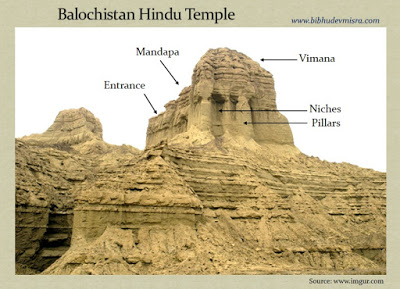
Fig 12: An ancient Indian Temple of Makran with Vimana, Mandapa, pillars and niches.
The question is, how old are these temples of Makran?
The Indus Valley Civilization extended along the Makran coastline, and its westernmost archaeological site is known as the Sutkagen Dor, near the Iranian border. Some of the temples and rock-cut sculptures of the region, including the Sphinx-Temple Complex, could, therefore, have been built thousands of years ago, during the Indus Period (c. 3000 BCE), or perhaps earlier.
It is possible that the site was built in phases, with some structures being extremely old, and the others comparatively recent. Dating rock-cut monuments, however, is difficult in the absence of inscriptions. If the site contains readable inscriptions, and if they can be interpreted (another tricky proposition, given that the Indus script has not yet been deciphered) then it may be possible to put a date on some of the monuments. In the absence of inscriptions, scientists will have to rely on datable artefacts / human remains, architectural styles, geological erosion patterns, and other clues.
One of the persistent mysteries of the Indian Civilization has been the profusion of exquisite rock-cut temples and monuments that have been built since the 3rd century BCE. How did the skills and techniques for building these sacred places of worship appear without a corresponding period of evolution? The rock-cut monuments of the Makran coastline may provide the much-needed continuity between the architectural forms and techniques of the Indus period and the later-day Indian civilization. It may have been on the mountains of the Makran coast that the Indus artisans honed and perfected their skills, which were later transported to the Indian civilization.
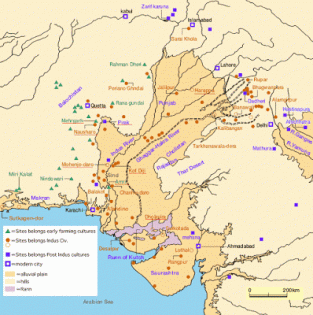
Fig 13: The Indus Valley Civilization included sites located along the Makran coast. Source: http://www.waa.ox.ac.uk
Undoubtedly, there is a virtual treasure trove of archaeological wonders waiting to be discovered on the Makran coast of Balochistan. Unfortunately, these magnificent monuments, whose origins go back to unknown antiquity, continue to languish in isolation, thanks to the appalling level of apathy towards them.
It appears that little attempt has been made to acknowledge or restore them, and the journalists routinely pass them off as “natural formations”. The situation can only be salvaged if international attention can be drawn to these structures, and if teams of archaeologists (as well as independent enthusiasts) from around the globe visit these enigmatic monuments to research, restore, and publicise them.
The importance of these ancient monuments of the Makran coast can hardly be overstated. They could be thousands of years old, and provide us with important clues to uncover humanity’s mysterious past..
[1] See for example: “13 natural rock formations that look man-made”, Angela Nelson, MNN.com 19 Jul. 2016 <https://www.mnn.com/earth-matters/wilderness-resources/photos/13-natural-rock-formations-look-man-made/sphinx-balochistan>;
Also see: “Natural Featured Sphinx of Pakistan”, Saamia Malik, CNN iReport 18 Dec. 2014 <http://ireport.cnn.com/docs/DOC-1198228>
[2] “Sphinx”,New World Encyclopedia <http://www.newworldencyclopedia.org/entry/Sphinx#cite_note-4>
[3] “Sphinx”, Theoi.com < http://www.theoi.com/Ther/Sphinx.html>
[4] Raja Deekshithar, “Sphinx of India, the Living Tradition” < http://www.chidambaramhiddentreasure.com/sphinx-in-india-tradition/ >;
Also see the You Tube Video: “Sphinxes of India”<https://www.youtube.com/watch?v=qGoJx0VMpXI>
[5] Raja Deekshithar, “Sphinx in Indian Art” <http://www.chidambaramhiddentreasure.com/sphinx-indian-art/>
[6] Raja Deekshithar, “THE SPHINX IN ANCIENT BURMA AND MODERN MYANMAR” <http://www.lchr.org/a/37/1q/myanmar.html>
[7] UNESCO, ‘Remembering the 1945 Makran Tsunami’, <http://iotic.ioc-unesco.org/1945makrantsunami/1945-makran-tsunami-booklet.pdf>
[8] https://pakistaniat.com/2007/03/02/mud-volcanoes-volcano-balochistan-baluchistan-hingol-offroad-makran-pasni-hinglaj/
[9] https://news.nationalgeographic.com/news/2011/01/110126-mud-volcano-new-island-pakistan-arabian-sea-science/
[10] André Wink, Al-Hind: The slave kings and the Islamic conquest (BRILL, 1991) 132
[11] André Wink, Al-Hind: The slave kings and the Islamic conquest (BRILL, 1991) 132
[12] André Wink, Al-Hind: The slave kings and the Islamic conquest (BRILL, 1991) 136
[13] André Wink, Al-Hind: The slave kings and the Islamic conquest (BRILL, 1991) 133
[14] André Wink, Al-Hind: The slave kings and the Islamic conquest (BRILL, 1991) 137
[15] André Wink, Al-Hind: The slave kings and the Islamic conquest (BRILL, 1991) 137.
[16] André Wink, Al-Hind: The slave kings and the Islamic conquest (BRILL, 1991) 135.

